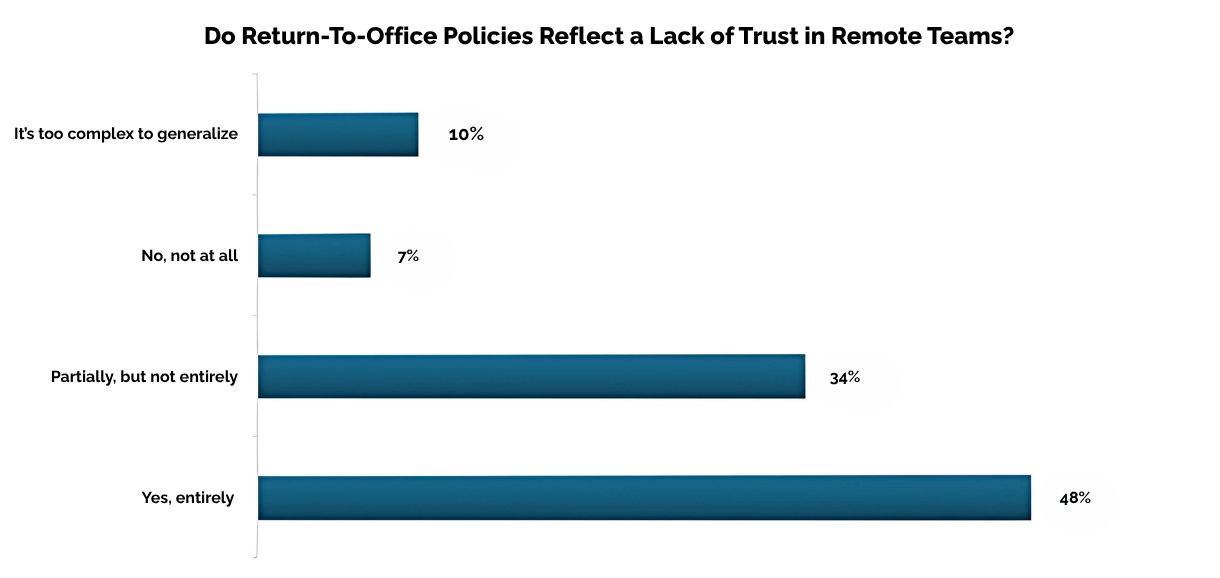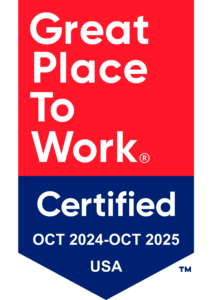Do Return-to-Office Policies Reflect a Lack of Trust in Remote Teams?
The return-to-office (RTO) debate continues to be a defining topic for organizations navigating the evolving world of hybrid work. While some leaders advocate for bringing teams back into the office, others are championing the flexibility and productivity offered by remote work. But what’s at the core of RTO policies? Do they stem from concerns about productivity and communication, or could they hint at a deeper issue of trust in remote teams?
We recently posed this question to our LinkedIn network through a poll, and what we discovered provides valuable insights into business leadership and workplace dynamics in today’s landscape.
Poll Findings at a Glance
We asked our LinkedIn audience, “Do return-to-office policies reflect a lack of trust in remote teams?” Here’s how 488 respondents voted:
- Yes, entirely: 48%
- Partially, but not entirely: 34%
- No, not at all: 7%
- It’s too complex to generalize: 10%
The results show that nearly 82% of respondents believe that RTO policies are at least partially rooted in concerns over trust in remote teams. This highlights the lingering complexities organizations face when balancing employee autonomy with leadership expectations.
Breaking Down the Responses
The majority of voters believe that trust plays a significant role in shaping RTO policies. However, each voting option offers additional nuances worth exploring:

1. Yes, Entirely (48%)
Nearly half of respondents felt that RTO policies wholly reflect a lack of trust in remote teams. For some leaders, the physical absence of employees leads to a perception that they are less accountable or productive. One anonymous comment underscored this perspective, stating,
“Every study shows companies perform better from home. This has more to do with companies paying for office space that isn’t being used. Since they have contracts, they’re forcing RTO.”
Another respondent highlighted the hidden motives influencing RTO policies, noting, “RTW is more than just empty office space. It’s being pushed to keep prices high in city centers and support local economies. But what really matters is talent communication and productivity—not appearance at a desk.”
These insights suggest that organizational trust may be tied not only to leadership concerns but also to larger economic and structural factors.
2. Partially, But Not Entirely (34%)
While this group acknowledged that trust plays a role, they believe it isn’t the only factor driving RTO policies. Some respondents pointed to the benefits of face-to-face collaboration. One shared,
“There’s so much synergy and learning during in-person interactions.” Another stated, “It’s nice to sit with the team and collaborate in person from time to time.”
This viewpoint suggests that while trust concerns may exist, they are balanced by the practical advantages of co-located teams, including real-time brainstorming, organic social interactions, and quicker problem-solving.
3. No, Not At All (7%)
A small percentage of respondents rejected the idea that trust is a factor at all. For these individuals, the push for RTO is seen as a strategic decision, separate from concerns about accountability. Some comments focused on how video and remote collaboration tools have shifted global workflows. For example, one respondent shared,
“I collaborate with people all over the world. Enhanced virtual work could make team efforts even more effective.”
4. It’s Too Complex to Generalize (10%)
Finally, 10% of participants acknowledged that the discussion isn’t black and white. One respondent captured the multifaceted nature of the topic, saying,
“Remote work is such a boon to work-life balance. If it’s possible for employees to work remotely, they should be able to do so.”
The conflicting priorities between organizational goals, employee satisfaction, and external economic factors make RTO policies highly situational, requiring a nuanced approach.
How Gravity IT Resources Can Help
At Gravity IT Resources, we understand the challenges businesses face in navigating these complexities. Our proven workforce solutions empower organizations to adapt to the rapidly changing work environment. Here’s how we help:
- Hybrid Workforce Optimization: We provide skilled talent equipped to thrive in a hybrid work model, leveraging technology to enhance communication and productivity across remote and in-office teams.
- Expert IT Staffing: We don’t just help you hire candidates—we help you hire the right people with the niche IT skills your company needs. Our team identifies talent gaps and provides expert advice on the skills required to drive collaboration, accountability, and transparency in a distributed workforce.
- Cultural Alignment Strategies: We help organizations foster trust and engagement through tailored strategies that align your leadership approach with employee needs.
- Nearshore Staffing Capabilities: We offer nearshore staffing solutions that connect you with remote tech talent in aligned time zones, delivering high-quality expertise while providing significant cost savings.
Whether you’re looking to enhance your remote work capabilities or implement a hybrid model, we’re here to support your goals.
Key Takeaways
The results of our poll indicate that trust (or perceived lack thereof) is a driving factor behind today’s RTO policies. However, the conversation is multi-dimensional, encompassing collaboration, economic influences, and workplace culture. Forward-thinking organizations that prioritize clear communication, results-driven productivity measures, and employee well-being will be better positioned to thrive in this dynamic work landscape.
It’s crucial for business leaders to remain adaptable and responsive to both employee and organizational needs. Building trust, empowering teams, and leveraging data-driven insights are the keys to success.



